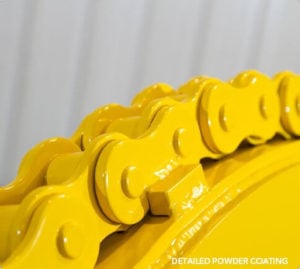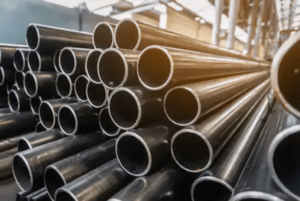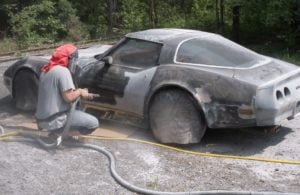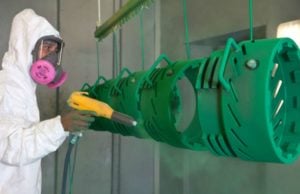What is Powder Coating?
Powder coating is a type of dry coating often used as a finish on industrial equipment as well as home goods. It was first used in the United States in the 1960s and is now one of the most popular types of finish for a variety of products and industries.
Powder coatings are applied as a dry powder using an electrostatic process before being cured with heat. They are known for providing a high-quality finish, both when it comes to the overall look and functionality of a piece. These coatings are known for their sturdiness and flexibility. They can be used on many types of surfaces, including steel, plastic, and concrete, which makes them suitable for both indoor and outdoor environments.
Powder coatings are one of the most durable and cost-effective finishing options. The powder coating process is more efficient than many other finishing methods. It is also one of the most environmentally friendly options available.
Related: Is Abrasive Blasting the Right Metal Finishing Solution for You?
How is Powder Coating Done?
The powder coating process requires some specialized equipment. The powder used can be one of two types: thermoplastic or thermoset. Thermoplastic powder becomes softer and more liquid when heated. In this case, there is no chemical bonding, which makes this form of powder coating reversible and reusable. Thermoplastic coatings are thicker and more durable than thermoset coatings, and for this reason, they are used on everything from refrigerators to auto parts to metal fencing.
Thermoset powder coatings work a little differently. They form chemical bonds when cured, which means they cannot be recycled in the same way thermoplastics can. They are ideal for high heat areas, as these bonds make them unlikely to melt away as thermoplastics would in the same situations. Thermoset coatings are often the cheaper of the two.
Once the type of coating is decided, the first step in the powder coating process is preparation. This is perhaps the most important part of any project, as it will determine how well the powder coating adheres to the surface it is intended to protect. Preparation can involve sandblasting as well as using a primer before applying the powder coating.
Powder coatings are usually applied using an electrostatic gun, which charges the powder before it is sprayed onto a surface. Then, the powder is sprayed onto the desired surface using compressed air. After the powder has coated the object’s surface, curing can begin, during which time the surface is heated to allow the powder to melt and form a film. Once it cools, the coating hardens, and the process is complete.
There are other methods of applying powder coatings, though they can be problematic or are only suitable for certain types of projects. For example, a metal surface may be heated prior to applying the coating, which allows the powder to melt on contact. The problem here is that it may cause excess powder to run, which creates more work and may require the process to be redone. Electrostatic fluidized bed coating is another method of powder coating and is a dipping process that cannot be used on larger pieces.
How Does Powder Coating Work?
Powder coatings are made up of several elements, including resin, curing agents, additives, pigments, flow modifiers, and extenders. The type of powder coating determines how much of each ingredient is included, but each serves a purpose in forming a coating that successfully protects a surface while giving it a more polished look.
Powder coatings need an electric charge in order to work. This makes them different from paint, which uses an adhesive. As the powder is ionized, this attracts it to the intended surface where it is cured at around 204℃ (400℉) and hardened.
There are many benefits to powder coating as opposed to painting and other types of finishes. Powder coating is more versatile and can bring a wider array of textures and thicknesses along with its superior protective abilities. Powder coating is impervious to chipping and scratching, which makes it more effective than paint on all types of surfaces.
The chemical bonding process is what gives powder coating its strength. When it cures, these bonds are solidified, and this allows more layers to be added to increase the thickness of the finish. Increased thickness means increased protection and a longer-lasting coating.
Powder coatings are primarily used to protect steel and other materials from corrosion. This is not their only use, but they are especially suited to this purpose. They repel corrosive materials like water and chemicals, preventing them from reaching the surface beneath the finish.
It is also important to understand how powder coating works in different environments. While it is stronger than paint, it is not infallible. Since the powder contains resin often in the form of epoxy, it reacts to sunlight in a similar way. If exposed to prolonged sunlight, the coating can become chalky and erode quickly.
How Durable is Powder Coating?
Powder coating is one of the most durable finishes for a variety of surfaces. Others provide more protection but can only be used on steel or other metals. The advantages of powder coating extend to several types of surfaces, and it protects each one thoroughly.
The chemical bonding that happens when a powder coating is applied creates a much more durable coating than finishes like paint. It can protect machinery as well as items used in the home on a daily basis. It can also withstand moisture and chemicals as well as extreme weather and physical impact. For this reason, it resists corrosion and other signs of wear like abrasions, scratches, and chips in the coating.
How Thick is Powder Coating?
Powder coating thickness can not only determine the level of protection but the functionality of a piece. Certain machine parts should not have a thick coating if they must quickly in close quarters with other parts, as it could reduce the machine’s efficiency. If a coat is too thin, on the other hand, it may not resist damage as well, and this is of equal concern.
The thickness of a powder coating depends almost entirely on the needs of the project. Unlike many other types of finishes, powder coating thickness can be adjusted. In cases like these, it is necessary to understand thermoset and thermoplastic properties, as thermoplastic can provide a thicker coating, though one should be careful of high heat environments.
Powder coating is not ideal if a project calls for a thin finish. Most of the time, a powder coating will be in the range of 6 to 12 mils. Depending on the process used, it can also exceed 15 mils. Therefore, on projects that require a thinner coating, a different finish may be a better option.
How Long Does Powder Coating Take?
The duration of the powder coating process depends on the project. Larger pieces require more time, as there is more preparation to be done and a broader area to be covered when it comes to both spraying and curing. For example, when coating wheel rims, each rim should not take more than two hours. The process can be finished within a day. However, it is impossible to estimate the time needed for all projects.
One fairly consistent piece of the process is curing time. Pieces are cured in a powder curing oven, a specialized piece of equipment used in the last step of powder coating application. The oven heats the item at 162-204℃ (325-400℉) for 10 to 30 minutes. The amount of time needed for curing depends on the size of the item and the thickness of the powder coat.
How Long Does Powder Coating Last?
The longevity of a powder coat depends on several factors, including powder coating type, the quality of preparation, and the environment in which the piece is housed. Most powder coats last anywhere from 15 to 20 years. However, outdoor environments, exposure to UV light, and consistent use or impact can cause the coat to break down faster.
Different powder coatings have varying lifespans, too. Coatings with urethanes and fluoropolymers tend to last longer, as they are made to withstand more extreme conditions and be more functional outdoors. Meanwhile, while coatings with epoxy can have a long life indoors, when used in the wrong environment, they can break down in a matter of months. This is why it is vital to be sure the proper coating is applied, as the wrong choice can cause as much damage as the correct one would prevent.
Additional Advantages of Powder Coating
Powder coatings have a number of advantages, which is why they are considered a top choice for industrial finishes. In addition to their legendary durability, they have other strong points that may not be immediately obvious or initially considered when choosing a finish.
Environmentally Friendly
Powder coating is one of the most ecologically friendly options available. The powder is often reusable and recyclable, especially when it comes to thermoplastics. This type of powder coating can be reshaped much more easily than thermosets.
The powder also is less likely to be wasted with this type of finish. When it comes to others, like paint, overspray is common, and as much as 70% of the paint can be wasted that way. Powder coatings tend to waste 5% or less in comparison. Powder coatings do not require solvents in the same way paints do, and they release very little volatile organic compounds (VOCs) that can be harmful to the environment.
Safe Option
In addition to being environmentally safe, they are also one of the most personally safe options. While it is still important to wear the necessary personal protective equipment (PPE), powder coating does not pose as much health risk even as paint. This is in part due to the lack of VOCs, which can cause respiratory problems.
Polished Look
Powder coating makes it easier to maintain a polished shine on equipment and even simple household items. Because it repels moisture, chemicals, and other harmful materials, it is also easier to clean. Reducing cleaning time means increasing efficiency when it comes to production or attentiveness to other matters in a facility.
Consistently attractive and cared for parts do not only add to functionality (though that is the main advantage in this case)—they also give a positive impression. Anyone who enters the area will notice that the facility is kept clean, which goes a long way in any industry.
Budget-Friendly
While the upfront investment can seem overwhelming, the cost over time of powder coating is lower than most finishes. It requires fewer materials and less equipment than more specialized finishes, and the low waste production means waste removal costs are lower as well.
Disadvantages of Powder Coating
Though powder coating boasts many advantages, they are not guaranteed to be the best choice in every situation. Using the correct finish can make a difference in efficiency and functionality in an industrial setting, or even in the home. Due to their flexibility and their many available types, powder coating has relatively few disadvantages, though it is essential to know what they are.
Less Coating Control
While the thickness of powder coatings is often an advantage, sometimes the opposite is true. It is difficult to control how thickly the powder covers the surface, and it can make for an uneven coating. This can also affect the coating’s texture, how well areas can be touched up, and whether the powder coating runs and needs to be redone.
Color Issues
While reusing the powder is generally a positive with powder coatings, it can also lead to color cross-contamination. This can lead to the colors not coming out right in the coat and make for mismatched touch-ups and lowered efficiency.
Powder coating is an excellent choice in many industries. It can be used on a variety of surfaces and materials and comes with a combination of durability, cost-effectiveness, and relative ease of application. While it may not be the best choice in every situation, powder coating provides a high-quality finish with a long list of advantages.
Related: Everything Engineers and Product Manufacturers Need to Know About Industrial Metal Finishing






